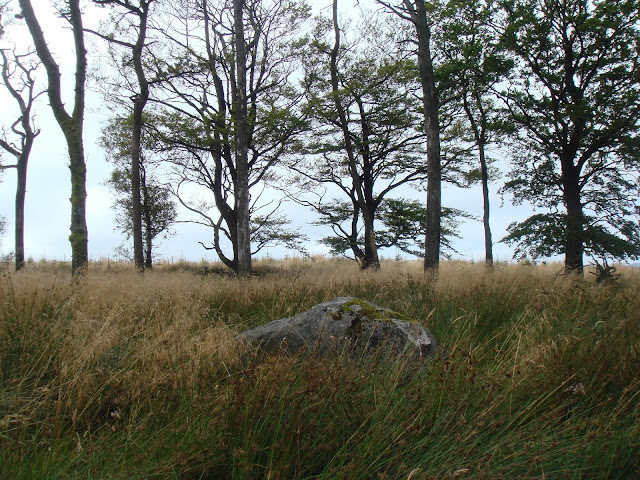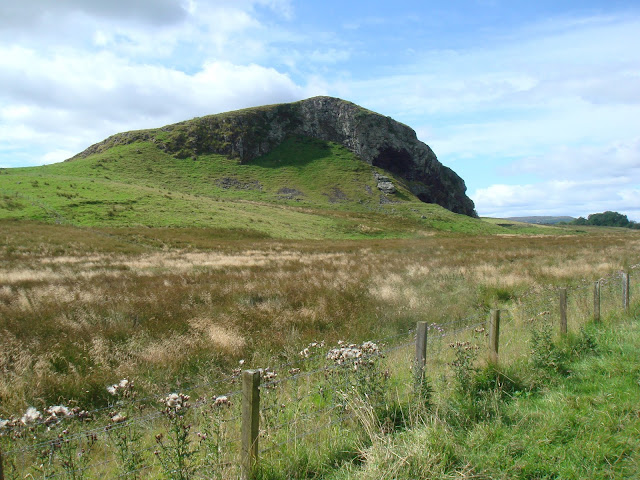Pretty simple really. There is only one road between Drumfrochar and Largs, and what a road!
For Knock Castle, just head into Brisbane Mains Farm and follow the waymarkers (on the map the red diamonds) up to Knock Hill and down the other side.
No sooner are we out the gate at Drumfrochar than we are met with views like this. It's a great start to any journey to be welcomed with such searing vistas, but also for its oxygenating factor: it's all uphill for the first half of the trip, steep at the very beginning but gentle thereafter, and then from Outerwards Farm, all gently downhill to Brisbane Mains Farm, or, if you want to miss out on the epic Knock Hill, to Largs, quite literally at the end of this, the Old Largs Road.

I first clocked this single track road way back when in 2010 when I cycled up the Gryffe Valley to the Kelly Cut and down to Wemyss Bay. I recall that day with astonishing clarity since the weather was deeply grey and misty, and cold. There was no-one about, and this only added to the spirit of the place. Today, though it may have been sunny and warm, I had a similar feeling. Maybe it's the lack of boundaries, the absence of walls and fences that leaves everything open. The roads belong as much to the cattle and sheep as they do to cars or cyclists. Furthermore, these single track roads, because of this, afford no hostile takeovers. The speed limit is set by the sheep and the cyclists. Like the Old Fairlie Road between Dalry and Fairlie, this is another old road that has embodied the poetry of place. Let's not forget that there was a time when roads were not monopolized by cars and white van man. And we're about to approach it....
Loch Thom & the uber-looking Dunrod Hill
From a kilometre or so before Outerwards Farm it's all downhill, and here we can just see Brisbane Glen at the far end of the road, and Knock Hill centre.
Looking back to Outerwards Hill. I spoke to the woman who works the farm and she told me the best way up is from the Skelmorlie end though there is a path of sorts up through Outerwards Farm too. Apparently, she told me, there's nothing to see, presumably of the old Roman signal fortlet that used to sit here. But I reckon there's plenty to see if you've got the right eyes, and what about those views? Anyway, another time... the downhill to Brisbane looked too enticing, and one hill is enough for one day.
Brisbane Mains Farm. Take the path leading from the road up through the farm. It's part of the Ayrshire Coastal Path that runs up to Wemyss Bay. The path here is not too bad though on the way down the other side it does tend to disappear in places.
It's more than manageable to take the bike up to the top. I actually cycled part of the path in those wetter parts as it's not too steep as it circles round and up. It certainly saved the feet from getting wet again. Here the view from Knock Hill looks down to Largs and Fairlie beyond.
Looking north from Knock Hill
Looking back the way we came.
Just keep your eyes peeled for waymarkers especially on the way back down if you're intent on getting down to the coast to the left. You could go back down the way you came, but I much prefer crossing the hill completely. Anyway, this waymarker here points you in the right direction. I cycled most of the way down through fields that were not too boggy or cow-trodden, but just be careful as they are big things hidden in that there grass.
When you come out onto solid ground, take the high road up above Knock Castle into Largs. Empty of cars, it's another beautiful little road with great views.
Looking back from Largs promenade you can see clearly Knock Hill in the distance.
CYCLING THE OLD LARGS ROAD
Improvement makes strait roads but the crooked roads without improvement are roads of genius. William Blake
God I love these roads!
These long sinuous causeways,
Slender and smooth,
Singularly affording no hostile takeovers
But instead forcing even the cars to talk to each other
to negotiate and to fare their way;
Where the cyclists cede to the sheep,
Where the give way sign is the way given
to all who are open to receive it
Where the grasses are more traffic than cars
Where speed limits are set by sheep and cyclist
and the odd stray cow
But this whole place is stray, riderless, unleashed,
Sacred like this cow, if only for a day,
from the oily chains of conventions
Where the only walls are hills and the only fences these long spears of grass
Where every encounter draws a pause
Enables a great inhalation
Where the desolation sings of spareness
An elegant frugality
Where the only excess is that of aliveness
and genius;
Where the right of way is disclosed
as the freedom to breathe, to inhale space,
to meditate amidst an undistracting landscape...
To contemplate the Way..




























































